The other day my golf buddy and I took advantage of an invitation to play an area course infamous for its difficulty. It lived up to its fearsome reputation, and after the round, over a beer in the clubhouse, we spent most of our time whining about how poorly we played.
We hadn’t played all the way back, but to better “experience” the course, we did elect to play the still-lengthy middle tees — well, for a few holes, anyway. Soon enough, we moved up to shorter tees so we actually could finish the round. Our mutual complaining centered mostly around how the course intimidated us and threw us off what limited games we had. By the end, scorekeeping had given way to mere survival.
Here was the problem, or at least it was for us: The course had elevated greens, meaning many second shots were, in essence, forced carries. A sobering analysis identified 13 greens we couldn’t reach in regulation. With a listed par of 72, this effectively made our par 85, allowing for two putts per green. (I realize we could one-putt some greens, just as we could three- or four-putt others, but two-putts are standard for course design.) The par-85 was actually generous, given that a couple of the second shots that were technically reachable called for skills neither of us exhibited often. But 85 it was.
Then I thought of our home course, where we occasionally shoot in the low 80s, or even the high 70s. That course is a par-70 and we can reach every green. So, after shooting, say, 82, there, our 19th hole conversation includes far more reminisces of good shots than bad, and the tone is never as negative as our “tough track” experience.
That’s when it hit me: to assess how my game has fared on a challenging course, I need to simply establish a “realistic par” for that course and then add to it what I normally shoot on my home course — 12 over or so. The resulting number is a good barometer for how I should I feel about my performance. In the case of the difficult course I played with my friend, I added 12 to our real par of 85. That equals 97, which is roughly what we both shot that day.
Nothing had changed about our rounds other than our understanding of how we had played. And in that process, our outing took on a different and frankly far more positive vibe. We had, in fact, played to our abilities!
Some might say there’s an easier fix for the problem I’m describing: simply move up a set of tees, as my friend and I did. But the solution isn’t that simple, because of how holes are designed. Contingent upon a hole’s par — 3, 4 or 5 — course designers give us one, two or three approach shots, plus two putts, to make par. If you’re standing over a shot to the green knowing you have no chance of making a two-putt par, the game can become unfriendly. This doesn’t happen to professionals or elite amateurs, but it’s a way of life for the rest of us.
Take a 430-yard par-4 that plays slightly uphill into the green. Let’s say your best drive is about 190-200 yards; knowing that would leave you a carry of 200-plus yards into the green, you move to a forward tee, making the hole 380 yards, or 50 yards shorter. Now, your second shot off the same drive is about 180-190 yards. GIR? Nope, still not happening! And that’s where the complications exist. Tees really should be positioned in terms of the approximate expected length of second shots and factor in whether players can run the ball up to the green or whether they must fly the ball there.
If tees are placed sensibly, two-putt pars should be achievable on all holes by all skill levels. If they’re not, try this: Compute the real par, accept the difference from the scorecard and enjoy your round.
